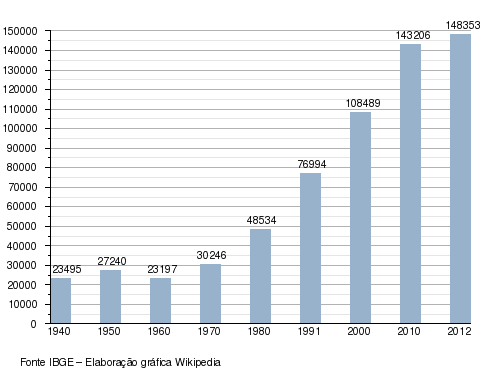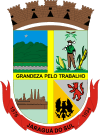Jaraguá do Sul
| Jaraguá do Sul | |||
|---|---|---|---|
|
View of the city from Morro da Boa Vista | |||
| |||
| Motto: Grandeza pelo Trabalho (Greatness through Work) | |||
 Jaraguá do Sul | |||
| Coordinates: 26°29′S 49°04′W / 26.483°S 49.067°WCoordinates: 26°29′S 49°04′W / 26.483°S 49.067°W | |||
| Country |
| ||
| Region | South | ||
| State | Santa Catarina | ||
| Founded | July 25, 1876 | ||
| Government | |||
| • Mayor | Dieter Janssen (PP) | ||
| Area | |||
| • Total | 532.590 km2 (205.634 sq mi) | ||
| Elevation | 30 m (100 ft) | ||
| Population (2012) | |||
| • Total | 148,353 | ||
| • Density | 278.55/km2 (721.4/sq mi) | ||
| Time zone | UTC-3 (UTC-3) | ||
| • Summer (DST) | UTC-2 (UTC-2) | ||
| Website | Prefeitura Municipal de Jaraguá do Sul | ||
| HDI (2006) 0.850 – high | |||
Jaraguá do Sul (26°29′10″S 49°04′00″W / 26.48611°S 49.06667°W) is a city located in the north of the Brazilian state of Santa Catarina.
History
The city was founded on July 25, 1876 by engineer and Brazilian Army colonel Emílio Carlos Jourdan and his family. The city was originally named just Jaraguá, but it was later renamed to Jaraguá do Sul due to a city already named Jaraguá in Goiás state.[1]
Etymology
Jaraguá means Lord of the Valley in a Tupi–Guarani language. It was the name given by the indigenous population of the city to the Boa Vista Hill (Morro da Boa Vista).
Geography
It borders Campo Alegre and São Bento do Sul to the north; Blumenau, Massaranduba, Pomerode and Rio dos Cedros to the south; Guaramirim, Joinville and Schroeder to the east and Corupá to the west.
The Itapocu River is Jaraguá do Sul's important river, crossing the city, being Jaraguá River and Itapocuzinho River its main affluents.
The climate is considered temperate, with average annual temperature around 21 °C. In summer temperatures often exceed 35 °C, although they may reach 40 °C in a few days. The winter is relatively cold for Brazilian standards, with an average minimum temperature around 12 °C in the months of June and July. Frosts occur almost every winter. Zero temperatures are rare, and that mark was reached most recently on July 14, 2000. The lowest temperature occurred on July 19, 1975, when thermometers recorded −2 °C. The highest temperature ever recorded was 42.5 °C on January 3, 1973.
Sports
Malwee/Jaraguá, formerly known as Associação Desportiva Jaraguá, is a successful futsal club, which have won the national league twice. In 2007, the city's arena, named Arena Jaraguá, hosted the final matches of the Grand Prix de Futsal.[2]
The city's football (soccer) club is Grêmio Esportivo Juventus. The retired goalkeeper Eduardo Roberto Stinghen, nicknamed Ado, was born in the city in 1946. Also, Filipe Luís, currently playing for Atlético Madrid, was born in the city.
Industry
The local economy is mainly based in metallurgy and clothing industries. The city was the origin for several worldwide companies, like WEG (electric engines and industrial electronics), Marisol (clothing), Duas Rodas (food seasoning), Malwee (clothing), Menegotti (construction equipment) and many others. The city is the 3rd largest economy of the state.
FEMUSC
Jaragua do Sul is home to the Festival de Musica de Santa Catarina which was created by Alex Klein. The festival is held in late January and attracts students and faculty from all over the world. The program involves faculty and students recitals, orchestral and band performances, lessons and masterclasses.
Schützenfest
The Schützenfest (also known in Brazil as Festa dos Atiradores) is a traditional festival held annually since 1988, celebrated in October in Jaraguá do Sul. It is part of the popular festivals celebrated in that month in Santa Catarina state due to the German colonization in the region.[3]
Demographics
Ethnic groups
The first inhabitants of the city were the indigenous people of the Xokleng and the Kaingang.[4] Later the following ethnic groups immigrated to the city: Germans, Hungarians, Italians, Poles, and Africans, which were brought to the city as slaves.[5]
Population growth

Bairros
Bairros in Jaraguá do Sul.:[6]
| Bairros | Localities | Tifas and villages | ||
|---|---|---|---|---|
|
|
|
References
- ↑ (Portuguese) Os prós e os contras de Jaraguá – Government of Santa Catarina
- ↑ (Portuguese) 3º Grand Prix de Futsal: Definidos os quatro grupos da competição – Futsal Brasil
- ↑ (Portuguese) Schützenfest – Turismo de Jaraguá do Sul
- ↑ (Portuguese) Jaraguá do Sul – Guia Santa Catarina
- ↑ (Portuguese) Etnias – Prefeitura Municipal de Jaraguá do Sul Archived July 28, 2011, at the Wayback Machine.
- ↑ "Listagem de ruas em ordem numérica" (PDF). Prefeitura Municipal de Jaraguá do Sul. Retrieved September 17, 2008.
External links
- (Portuguese) Jaraguá do Sul City Hall

